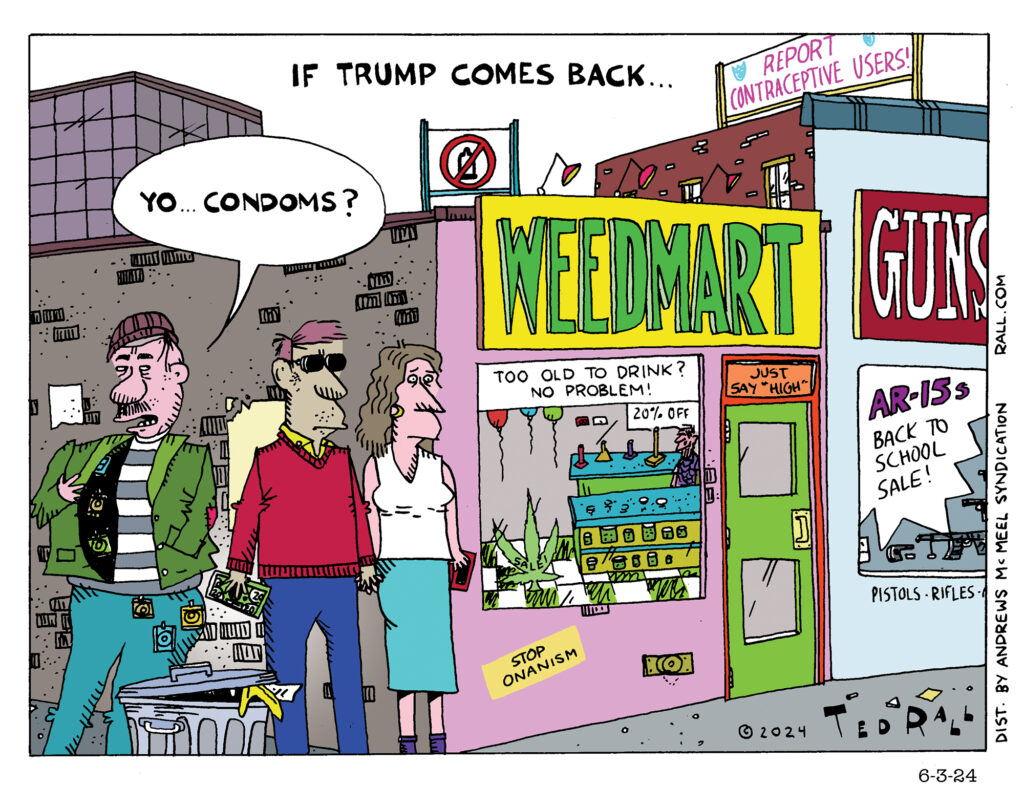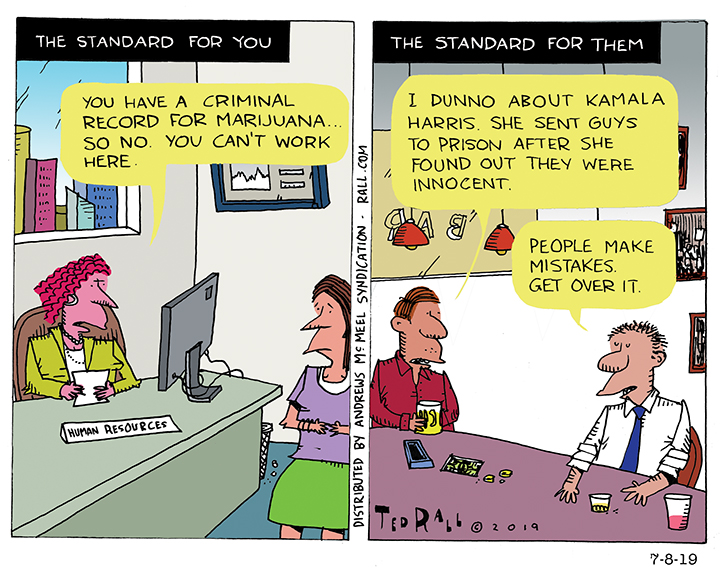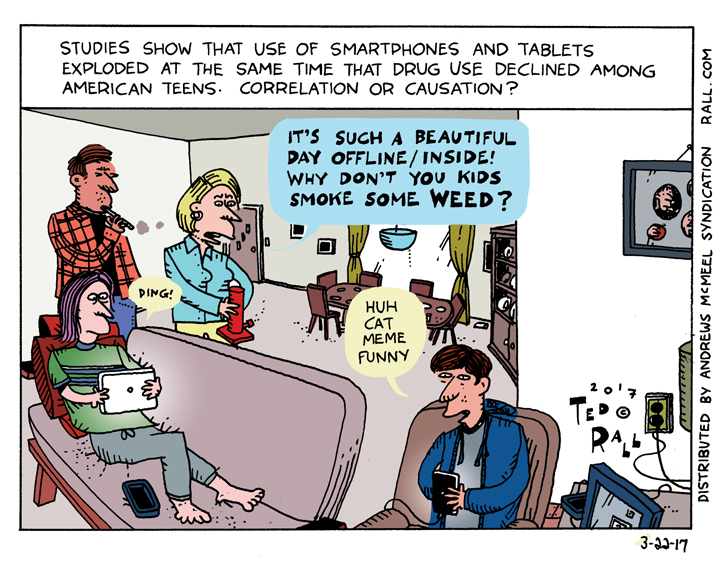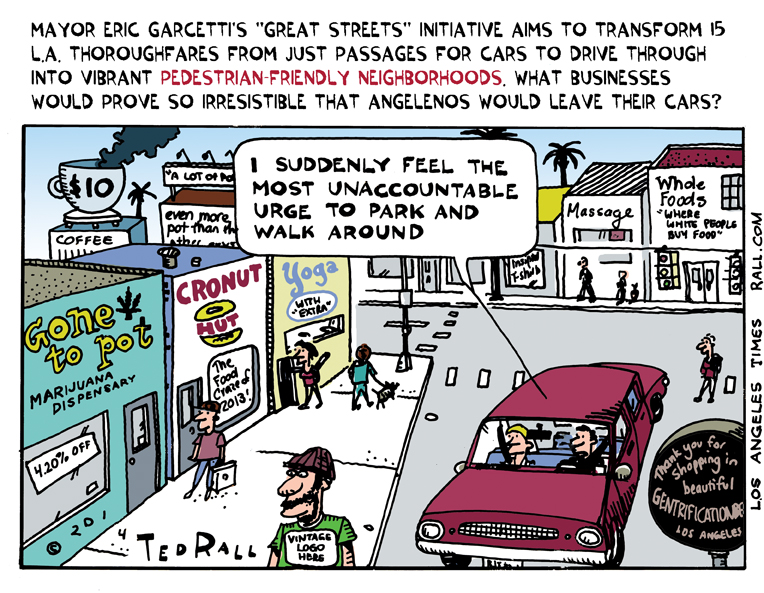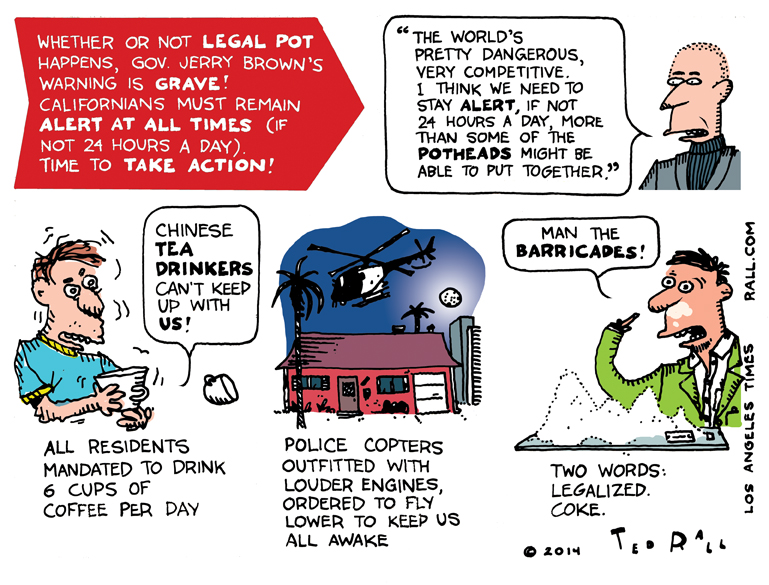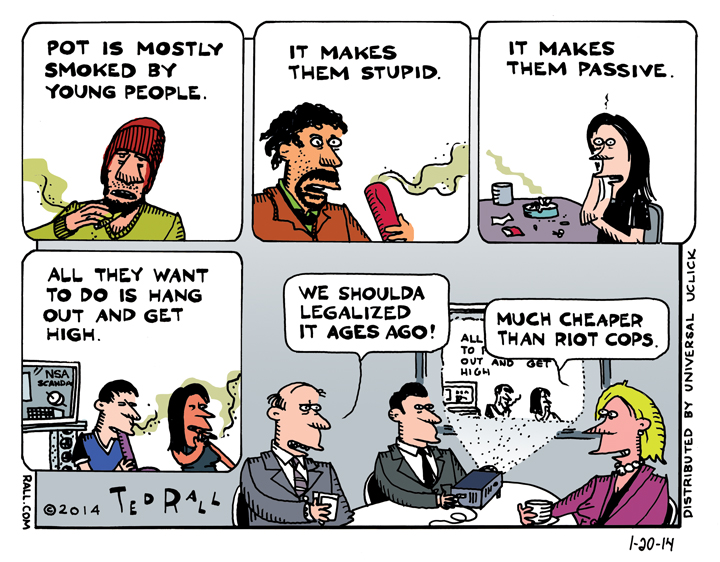Donald Trump’s plan for his second term includes a push to make it harder to obtain birth control. This follows several other Republican-led initiatives to make it more difficult for Americans to use contraception, including condoms. What’s next, forced impregnation? Guns and marijuana, on the other hand, are still easy to get.
From Pot to Jaywalking, Pay Compensation to Those Hurt by Repealed Laws
Whether it’s a soaring literary classic like Les Misérables or generic Hollywood product like The Butterfly Effect, I’m drawn to stories in which a minor event triggers a series of unforeseen dramatic events. As Springsteen wrote and Dave Edmunds sang, from small things big things one day come.
A real-life example transpired three weeks after the 9/11 attacks, when I was falsely accused of jaywalking — a misdemeanor at the time — by an LAPD officer who roughed me up and handcuffed me to boot. For 14 years, nothing happened as the result of that arrest on October 3, 2001. In the summer of 2015, without warning, getting busted for jaywalking blew up my life.
Tiny problems can wreak havoc. Like the O-ring. Hell, I got expelled from college over a wart.
The jaywalking thing cost me my job as the staff cartoonist at the Los Angeles Times, damaged my reputation to the point where I was nearly blacklisted from journalism and cost me friends and colleagues. It made me doubt the ability or willingness of journalism, the love of my life, to do the right thing. It convinced me beyond a reasonable doubt that the justice system is hopelessly corrupt. I drank too much. Who knows—the weight I gained may eventually kill me.
I am grateful for every day that passes when I don’t think about jaywalking or the LA Frigging Times. Unfortunately there was no way to distract myself this week. California governor Gavin Newsom signed a new law decriminalizing jaywalking. As of the first of the coming year the Freedom to Walk Act means you’ll be allowed to cross a street in the Golden State—safely! look both ways before crossing, like mom taught you—without fear of being fined, handcuffed, beaten, arrested or even killed by a lunatic cop unless “a reasonably careful person would realize there is an immediate danger of collision with a moving vehicle or other device moving exclusively by human power.” (The legislation is silent on devices powered by other animals or plants.)
Jaywalking tickets are big business in California. In Los Angeles alone, the LAPD raised $6.2 million in revenues by fining 31,712 accused jaywalkers between 2010 and 2020. Blacks were targeted more than three times their presence in the population.
Several well-meaning readers contacted me to inform me of California’s new law, which I support wholeheartedly except for an all-too-common omission: it’s not retroactive. Those who have suffered fines, imprisonment and other punishments under a law that is subsequently repealed ought to be made whole. If slaves were emancipated by the conclusion of the Civil War in 1865, escaped slaves and those who helped them who were punished for their “crimes” should receive apologies and restitution by 1866. Merely erasing a conviction from your criminal record, as some states that have legalized marijuana have done, isn’t enough.
Anyone who is charged and convicted for a crime that is no longer a crime ought to be refunded their fines and attorneys’ fees, plus compound interest charged at the highest credit card rate. Anyone who spent time in jail or prison for an offense that is no longer viewed as an offense under the law should be generously compensated by the state or city responsible for their conviction.
Even if California were to come to its senses and pay millions of dollars in penance to everyone who suffered under bigoted jaywalking laws that were originally conceived by automobile companies as a way to discourage walking and sell more cars, there still wouldn’t be any way to undo all the weird side effects of what we now recognize as an obsolete form of oppression.
For poor Californians, the $196 jaywalking fine was devastating. Under our vicious capitalist system, there can be no doubt that some people failed to make rent and even lost their homes after being targeted by police enforcing this idiotic statute.
As a solvent, able-bodied, white, cis male, Ivy League graduate, paying the citation was no big deal. But even for me, it was a train wreck.
Upset about being falsely accused — I wasn’t jaywalking, the cop made it up — and mistreated, I filed an internal affairs complaint against the officer back in 2001. Citizens are ignored in such cases 96% of the time, and I was no exception. By 2015 I had been working for the LA Times for six years. But I didn’t know two things. First, a thin-skinned police chief was furious every time I drew a cartoon criticizing the police. Second, in 2014, the LAPD union bought an interest in the parent company of the LA Times and formed an obscene corrupt alliance with the paper’s publisher, multibillionaire Austin Beutner.
In 2015 Beutner and Chief Charlie Beck held a secret meeting where, clearly needing more important things to do to fill their time—they should try golf, the evil rich love it—they conspired to ruin me. Beck dredged up my old IA complaint file, which contained an audio recording the cop had made of my jaywalking arrest: basically six minutes of wind and street noise. At Beutner’s direction the Times wrote a piece that argued the cop was kind and polite, and that my description of the encounter in a Times blog piece was false, so I must be fired for crimes against journalism.
Fox News, Breitbart and the rest of the right-wing mediasphere had a field day dragging the corpse of my reputation across the Internet.
Ultimately, I was vindicated. The doctoring of the tape, the Beck-Beutner conspiracy, the fact that I’d told the truth about what happened in 2001 while the LAPD Times had lied all came out in the media and through the course of a lengthy court battle. There’s no telling how much work I’m not getting as a result of the Times’ defamation campaign, though I am working.
The experience changed me, mostly for the worse.
Nothing could make me, or the other people hurt by California’s repealed jaywalking law, whole again. But the state should try.
Every state should try, every time it repeals a bad law.
(Ted Rall (Twitter: @tedrall), the political cartoonist, columnist and graphic novelist, co-hosts the left-vs-right DMZ America podcast with fellow cartoonist Scott Stantis. You can support Ted’s hard-hitting political cartoons and columns and see his work first by sponsoring his work on Patreon.)
Your Opinion Doesn’t Matter. Protests Matter.
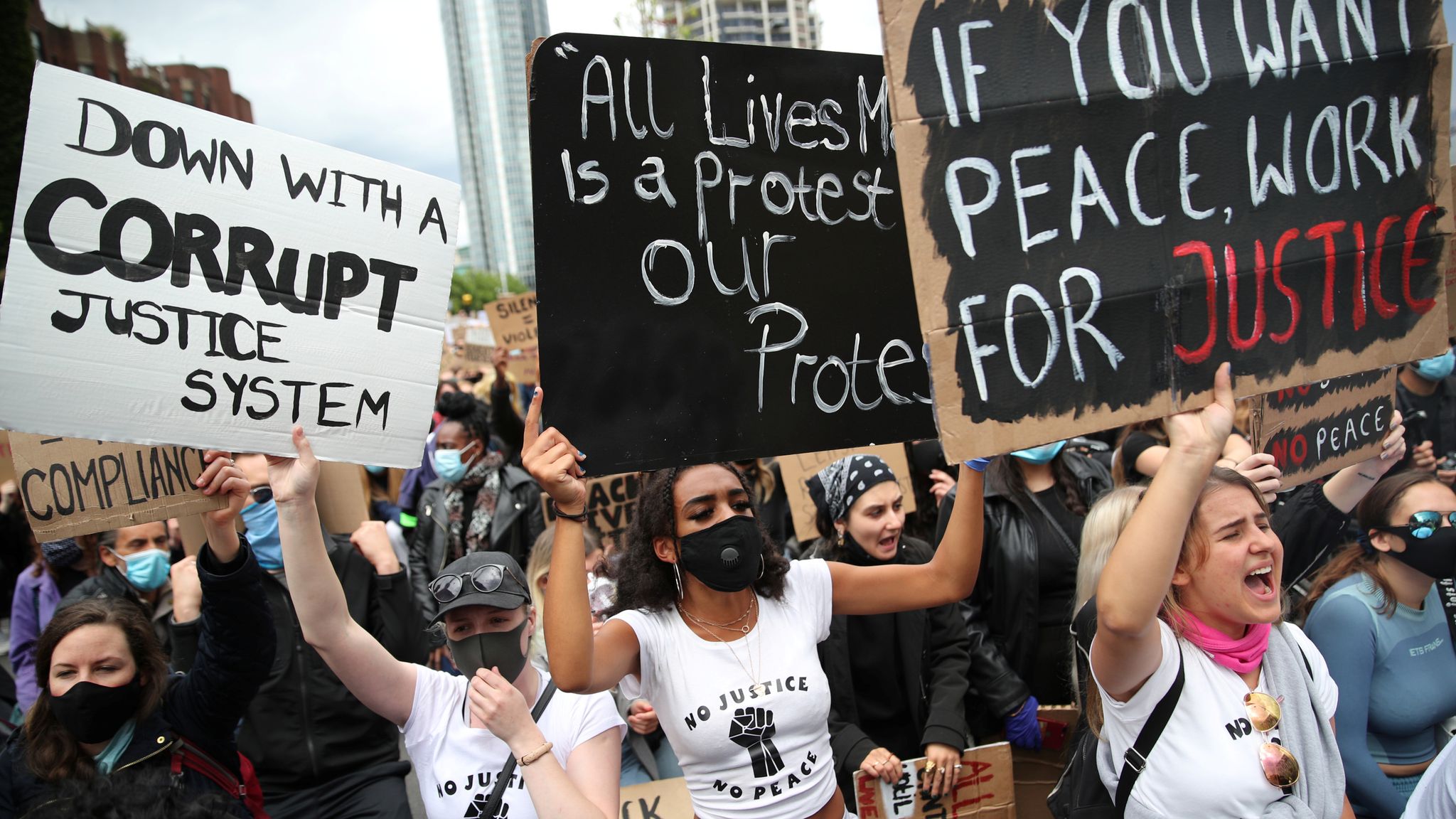
Your opinion doesn’t matter—not by itself. No matter how heartfelt or important to you personally, your thoughts about Gaza or legal weed or the war on skinny jeans don’t mean anything merely because they reside inside your brain.
Your opinion matters only if you express it. Expression of an opinion doesn’t change anything unless it’s done effectively. Opinions expressed en masse, alongside others who share your views, are more likely to effect change—but that’s not enough to move the needle. What changes policy, what improves lives for the foreseeable future, what makes history on a radical scale, is a sustained mass movement that expresses an opinion so aggressively that the ruling classes are forced to change course or risk losing their power and privilege to revolutionary overthrow.
American liberals and leftists have strong opinions on a variety of issues. But they express them on the couch or online rather than in the streets, where it matters. On the rare occasion when we venture into the public sphere, our protests are usually sporadic and unsustained, like the annual anti-Trump women’s marches with the pink pussy hats or militantly nonviolent, like the antiwar protests leading up to the 2003 U.S. invasion of Iraq. Neither had any effect. Leftie demonstrations rarely assume the dangerous character required to scare the powers that be: violent, or nonviolent while brandishing a credible threat of violence.
Last summer’s Black Lives Matter protests were an exception, continuing every day for well over 100 consecutive days in over 500 cities, involving between 7 and 22 million people. Though mostly nonviolent, BLM demonstrations featured sufficient property damage and violence to lend the peaceful events a menacing swagger. Which is why BLM was effective.
Racist and brutal police are still a big problem. But BLM moved the ball down the field more than anyone would have expected previously. Defunding the police went from fringe to mainstream with cities like New York, Los Angeles and San Francisco actually moving millions of dollars in their budgets. Chokeholds have been banned in dozens of cities. Confederate statues, the Stars and Bars at NASCAR, the names of sports teams and products whose names invoke the legacy of racism are biting the dust. Equity has become a policy priority for public educators.
Liberals, progressives and leftists should take note of BLM’s successes and emulate their tactics for other causes. It’s time to relearn the lessons of the 1960s. Street activism works when it’s sustained—and a little dangerous.
For the first time in memory a majority of Democratic voters tell pollsters they support the Palestinians in their struggle against apartheid in Israel and the brutal occupation and theft of land in the Palestinian Territories. Nice to see. But your disgust at the Israeli bombing of Gaza can’t be enough to help the Palestinians or pressure Congress to cut off the $4 billion in aid Israel receives each year from U.S. taxpayers. You have to fight for it.
68% of voters want to add a public option to Obamacare. (And 55% want Bernie Sanders’ Medicare For All.) The public option was one of Biden’s campaign promises but now he’s reneging. Two out of three voters is a big number, but Democrats won’t have to make good on their promises as long as we sit on our asses at home.
63% of Americans say they want the minimum wage to go up to $15-an-hour immediately. Yet Democrats haven’t even announced a bill for their watered-down, half-hearted proposal to scale up to $15 by 2025. Biden and the Democrats talk to big-business donors and lobbyists, not you and me. Public opinion doesn’t matter by itself.
Want the U.S. to use its enormous military and financial influence over Israel to force movement toward a two-state solution that emancipates the people of Palestine? Get out into the streets. Stay there. Be militant. Don’t stop until you get results.
Want Congress to finally get serious about America’s insane for-profit healthcare system so that anyone who’s sick can see a doctor? Fill the streets of hundreds of cities for months at a time and refuse to leave until the corrupt fools in Washington see reason and let us join the numerous other nations who provide for their people’s basic needs.
Want a living wage for anyone who puts in a full day’s work? Don’t just think it—do it. Go out there, confront the cops, refuse to be cowed, make everything stop until employers are forced to do the right thing.
Last year’s BLM protests were fueled in size and intensity by the COVID-19 lockdown and high unemployment. Now that workplaces, schools and entertainment venues are reopening, it’s tempting to return to the ad-hoc passive activism of the pre-pandemic era. But wimpy succumbing to “free speech” zones to express grievances on the occasional Saturday or Sunday didn’t work then and it won’t work now. We need to rock the streets every day, hard, like it’s 2020 or 1968.
(Ted Rall (Twitter: @tedrall), the political cartoonist, columnist and graphic novelist, is the author of a new graphic novel about a journalist gone bad, “The Stringer.” Now available to order. You can support Ted’s hard-hitting political cartoons and columns and see his work first by sponsoring his work on Patreon.)
LOS ANGELES TIMES CARTOON: Great Streets? Or Just Gentrification?
One of the last books published by the modernist author Sherwood Anderson (now known for his revolutionary, transgressive short story collection “Winesburg, Ohio“) was “Home Town,” a WPA-funded 1940 examination in prose and photos of the waning small American town, with its inevitable strip of unpretentious diners, practical hardware stores and other staple businesses around which community life revolved. Even in the late 1930s, the rise of the automobile was expanding horizons, enabling sprawl and killing the intimacy of smaller communities that Anderson, like many Americans, found simultaneously comforting and stifling.
Decades of highway construction drove development away from urban centers all over the country and around the world, but nowhere has that phenomenon been more pronounced than Los Angeles, a city of more than 3.8 million people with such a remarkable absence of a clearly delineated central downtown — “Downtown” itself having become a ghost town at night and, for that matter, during many hours of the day — that it does not contain a highly symbolic target for post-9/11 terrorist attacks.
The Urban Dictionary calls L.A. “a massive tangle of highways and roads, also rumored to contain people and houses.”
For at least half a century, however, Americans have suffered a case of automotive and suburban remorse in the form of angst-ridden cris de coeur in the vein of Richard Yates’ “Revolutionary Road” (1961). A notable architectural reaction against sprawl was/is the New Urbanism movement that began in the 1980s, an attempt to recreate the small-town vibe documented by Anderson by increasing population density in new developments centered around pre-fab mini-downtown business districts that seek to be pedestrian-friendly.
Mayor Eric Garcetti’s “Great Streets” program follows this tradition, though at a scale whose ambitions are currently constrained by a lack of “the money and the space to add the types of transportation that would significantly reduce traffic congestion, such as widening streets or adding expensive mass transit,” write David Zahniser, Matt Stevens, and Laura J. Nelson in the Times.
“In a process the mayor describes as ‘urban acupuncture,’ the city plans to add bike racks, plazas, crosswalk upgrades and other amenities aimed at drawing in pedestrians and attracting new businesses” to 15 thoroughfares.
Some Angelenos are skeptical. Some worry Great Streets will fail, as have similar initiatives attempted by Garcetti’s predecessors. Others worry it will screw up traffic, a perennial problem in the city. Then there are those who worry it will work:
“In Highland Park, once sleepy York Boulevard has become a magnet for an array of middle- and upper-middle class needs: coffee, comic books, vegan ice cream, and $5 donuts. Abbot Kinney Boulevard in Venice, once favored mainly by locals, is now a regional tourist destination with prices to rival Rodeo Drive. Backers of the Great Streets program hope to achieve similar success.”
Overpriced coffee, pretentious deserts and overpriced pastries spell one thing: gentrification, the process of “improving” a neighborhood by driving up rents and expelling long-time residents, many of whom happen to be poor and/or have brown skin. (I’m OK with stores that sell comics, though.)
Aside from inconveniencing poor people and minorities with evictions and forcing them to commute from more distant suburbs to their jobs, gentrification makes neighborhoods strips ethnic flavor and makes them bland. Surely it should be possible to attract pedestrians to city streets minus gentrification — a mix of commercial rent control, curation of businesses and guarantees to long-term residents that they will be allowed to remain over the long run — but it hardly happens after the developers get involved. Given this history, it’s far more likely that Great Streets will become Great Streets for Upscale White People.
LOS ANGELES TIMES CARTOON: Why is Gov. Moonbeam so afraid of legalized marijuana?
Here is my cartoon this week for The Los Angeles Times:
The statewide legalization of marijuana in Colorado, for recreational as well as medicinal use, has prompted serious consideration of the drug’s health effects and socio-political ramifications. Well, that sure took awhile.
On the pro side, it’s been pretty much established that driving stoned isn’t nearly as dangerous as driving drunk. Since 7% of California motorists are cruising the state’s freeways with cannabis in their systems, that provides some comfort. (Sorry, no word on what percentage of the stoners are drunk as well.) Pot also has proven medical benefits; for example, parents of epileptic children are flocking to Colorado.
But the legalize hemp crowd’s timeless rant that pot is harmless is taking some hits.
A recent study claims to have documented the first two known cases of pot-related fatalities. Other studies find that beginning to smoke weed as a teenager — the most common age to start — can affect brain development, causing memory loss, permanently impaired judgment and even reduced IQ.
In musings that might surprise those who remember his “Moonbeam” period (but not those who have noticed there’s no squarer square than an old hippie), Gov. Jerry Brown took to Sunday morning TV to worry aloud that emulating Colorado could leave the state defenseless against (a) foreign business competition and (b) terrorism.
“How many people can get stoned and still have a great state or a great nation?” Brown mused. “The world’s pretty dangerous, very competitive. I think we need to stay alert, if not 24 hours a day, more than some of the potheads might be able to put together.”
The governor didn’t say whether his garbled grammar was attributable to pot or the shortcomings of his secondary education.
I’m always interested in policy appeals motivated by fear. Politicians have unleashed an awful lot of threats — a few real but mostly imagined — during the last decade and a half. And they haven’t exactly made us a better, stronger or more economically successful nation. Brown’s thoughts are nowhere close to the depraved paranoia of Dick Cheney; the idea that California will be morally and economically weakened, its security undermined, because a tiny minority of the state’s residents regularly indulge in the evil weed seems about as serious and substantial as a puff of smoke.
Stay alert? What’s going to happen if we don’t, governor? Are Chinese sweatshop workers going to take a fiscal victory dance on the bones of our stoner-sapped competitiveness? Will our collected stonedness open up the one big chance radical Islamists have been waiting for?
Californians won’t have the chance to vote for legalized pot until November 2016 — if they’re not too wasted to remember.
SYNDICATED COLUMN: If We Learn Geography, the Terrorists Have Won
When You Ask “Why?,” Mean It.
Why?
Why would anybody want to kill innocent people?
That’s what Americans — led by the media reporters and pundits who set the agenda for discussion — ask after every terrorist attack, particularly those carried out by foreigners.
Our mystified national cluelessness begs the question. Why do people blow up our embassies, bomb our ships, fly planes into our buildings, (try to) blow up their shoes and their underwear? They do it (partly) because we can’t imagine why anyone would do such a thing.
Studies, particularly the ones the media trots out at times like these, point to a number of factors. Some of these may help trigger the kind of violent “self-radicalization” that initial reports indicate may have led Tamerlan and Dzhokhar Tsarnaev, Kyrgyzstani brothers of Chechen descent, to detonate a pair of bombs at the Boston Marathon last week.
Was it psychological alienation? “I don’t have a single American friend,” Tamerlan, 26, supposedly the instigator of the attack, said. A traumatic event, like a job loss or the break-up of a romantic relationship? Some studies find that some self-radicalized (as opposed to those who are recruited into an organization) terrorists are made after they suffer a disappointment that sets them off, causing a person with political rage to graduate to violent direct action. After the Fort Hood shooting, the Pentagon concluded that substance abuse, post-traumatic stress syndrome or brain injuries sustained in an IED blast could be triggers. Some even blame the involvement of Dzhokhar, 19 and suffering from multiple gunshot wounds, on reports that he was a pothead.
But hey, one could just as easily ask what drove state terrorist Barack Obama to murder thousands of innocent people with killer drones. Was the president sad after failing to win a second Nobel Prize? Did Michelle stop putting out? Did cocaine and/or marijuana scramble his right temporo-parietal junction, the part of the brain that controls the moral judgments of human beings? It’s pretty safe to say we’ll never be able to point to one, or two, or 17 discrete factors as the “causes” for the conscious choice to kill another person.
Like the drone war, the Boston Marathon bombings were a political act.
At this point, my best guess is that this was an attempt to strike back at the U.S. in its post-9/11 “great war of civilizations,” or Christian “crusade,” as George W. Bush called it. Authorities who questioned Dzhokhar in his hospital bed say that he and Tamerlan wanted to defend Islam from attack.
You can argue that the Tsarnaev brothers’ politics were wrong. That their tactics were counterproductive. That they were just “losers,” as their uncle called them. But we can’t understand why unless we dig into those politics.
Which is something that, 12 years after 9/11, the American media still refuses to do. Which increases the odds of future attacks.
Terrorism is not prima facie the act of a nut. Serial killers don’t detonate bombs. Terrorists don’t terrorize for fun.
“Terrorism [as opposed to state terrorism, like the drone wars] is the tool of the weak, used by disaffected groups or minorities to oppose the rule and (as they see it) the oppression of an established and militarily superior power,” Mark Nicholson wrote. “Because it is resistance on the cheap, terrorism often emerges out of civil society rather than state sponsorship, because oppressed civilian groups, lacking control over governmental machinery, can summon little or no regular military force able to confront their ‘oppressor’ in conventional military terms.”
We like terrorists. Some of them, anyway. During World War II German occupation forces characterized the leaders of the Warsaw ghetto uprising as “terrorists.” We view these doomed Jews, who fought to the death, as noble. The Afghan mujahedeen who struggled against the Soviets during the 1980s were terrorists to the USSR, “freedom fighters” to Ronald Reagan. The French Resistance assassinated public officials and robbed banks and bombed trains, and we love ’em for it. In movies like “Red Dawn,” we cheer the patriotic American “terrorists” who wage guerilla warfare against the invaders.
This, of course, is how radical Islamists see themselves: as heroic fighters in a resistance movement against a rapacious, cruel oppressor. (And if they prevail, that’s how history will read.) They’re not psychotic. They’re principled, willing to sacrifice everything for their cause.
Since 9/11 our leaders have repeatedly told us that “they” “hate our freedoms,” but of course this is nonsense. As Osama bin Laden remarked, if the Islamists resented liberal societies, if they wanted the world’s women all under burqas, Amsterdam would have been blown to bits. “We only killed Russians after they invaded Afghanistan and Chechnya, we only killed Europeans after they invaded Afghanistan and Iraq,” bin Laden wrote in 2004.
To ask why Tamerlan and Dzhokhar Tsarnaev did what they did (if indeed they did it), to research their political motivations with an open mind, without dismissing them as random (friendless, stoned, loser) crazies, does not legitimize their tactics.
Self-styled Islamist resistance organizations like Al Qaeda haven’t garnered widespread support because terrorism against civilians is counterproductive. As Ché Guevara wrote, “terrorism [is] a measure that is generally ineffective and indiscriminate in its results, since it often makes victims of innocent people and destroys a large number of lives that would be valuable to the revolution.”
However, as Ché continued, terrorism directed against government or military officials can be legitimate: “Terrorism should be considered a valuable tactic when it is used to put to death some noted leader of the oppressing forces well known for his cruelty, his efficiency in repression, or other quality that makes his elimination useful.” After 9/11, for example, even some Americans viewed the Pentagon as a legitimate military target. Conversely, arguments that the World Trade Center, as a hub of a “technocratic corps at the very heart of America’s global financial empire,” was an acceptable target, were rejected. The WTC victims enjoy an exalted sainthood in popular culture; grief over the Pentagon victims has always been relatively muted.
No would-be revolutionary who knows history would have targeted a civilian target like the Boston Marathon.
So, let’s agree that the brothers’ tactics sucked. That what they did was evil. But what of their political motivations?
One would have to be blind not to understand why Muslims are enraged at the U.S.: Gitmo, drones, propping up dictators, Palestine, Abu Ghraib, Afghanistan, Iraq, the list goes on and on…and yes, Chechnya — where the Russians slaughtered thousands of innocents while their American allies silently cheered them on.
But few of us know about that. Because our media didn’t report it.
Which gets us back to:
Why’d the Boston bombers do it?
To get us to pay attention.
So we’ll force “our” government to stop what they’re doing in Muslim countries.
But that’ll never happen until we know “we’re” doing.
(Ted Rall’s website is tedrall.com. His book “After We Kill You, We Will Welcome You Back As Honored Guests: Unembedded in Afghanistan” will be released in November by Farrar, Straus & Giroux.)
COPYRIGHT 2013 TED RALL

